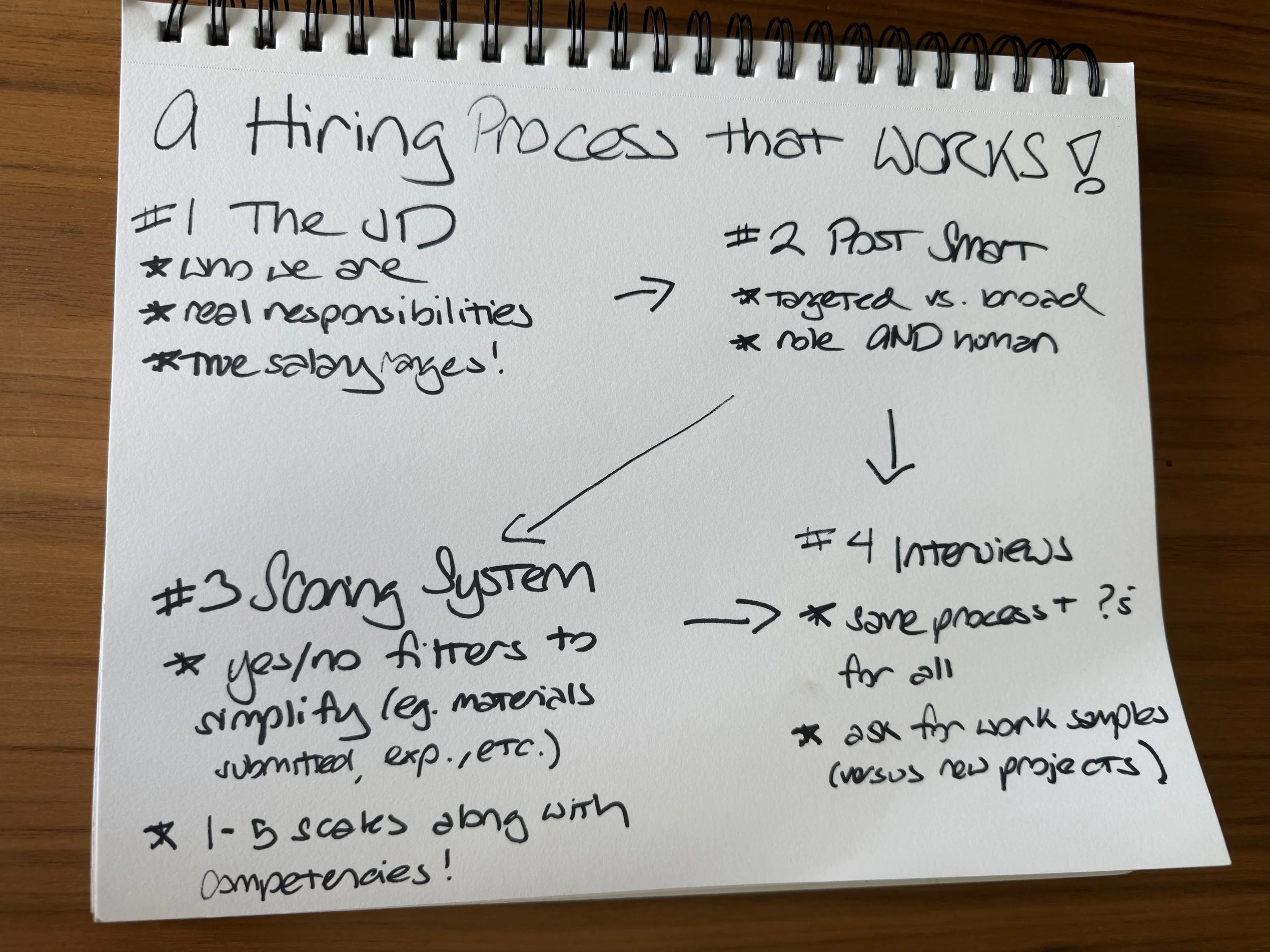Hiring with Heart and Strategy: A Process That Works
Summary:
Knowing what you want is one thing. Actually getting those candidates to apply and running a process that helps you choose the right person is another. Sophia's approach transforms hiring from a chaotic scramble into a systematic, equitable process that saves time, reduces bias, and helps both you and candidates make better decisions.
What’s in it for you:
You know your ideal candidate but struggle to attract the right applicants
You're drowning in applications and need a fast and fair way to review them
You want a hiring process that sets candidates up for success
You're tired of hiring processes that drag on forever or miss great candidates
Helia’s Perspective
Knowing what you want is one thing—doing the work to actually get it is another! A friend recently worked with Sophia Zisook, and hearing through the grapevine, I really appreciated how straightforward and practical her approach was.
When we chatted, I was immediately struck by how she'd been on both sides of messy hiring processes, which is exactly why her advice feels so real. What I love about Sophia's approach is that it's not theoretical. She's lived through unclear job descriptions, inequitable compensation, and those endless interview processes that go nowhere. So when she walks you through creating a scoring system or writing a job description that actually works, it comes from someone who's been frustrated by bad processes and figured out how to fix them (some of my favorite kinds of humans!).
Once you've figured out the right role at the right level and identified who will thrive in your culture, you still need a systematic way to actually find, screen, and evaluate those people. And Sophia's refreshingly direct about things like entry-level hiring: too many organizations hire junior people because they can't afford senior folks, then expect them to perform without the support they need. That kind of honesty is exactly what makes her guidance so valuable.
Sophia’s Story
"I started Negotiate with Sophia organically coming out of research I did in my master's degree at University of Chicago," Sophia told me. "I became fascinated with what are the different cultural and societal influences that prevent folks from negotiating on their own behalf and make it less likely for them to be successful."
That research led to a business helping individuals negotiate for themselves. But as she gained experience in the social sector—from co-founding a youth-serving nonprofit at 18 to working across organizations—she kept seeing the same patterns: "Most organizations are really small and nimble and scrappy and are building the plane as we fly it."
The problem? "I had been on the receiving end of really messy or unclear interview processes, inequitable compensation, and botched communications internally. I'm a big proponent of if there's something wrong, I want to figure out how to make it better."
Now she helps organizations put equitable hiring practices into action "without breaking the bank or scaling in a way that wasn't realistic for that organization."
Her approach is refreshingly practical: create systems that work for small, nimble organizations while ensuring every candidate has a fair shot.
The northern lights, visible from a park 30 minutes from Sophia’s home
What this Looks Like in Practice
-
"When folks are thinking about hiring, obviously one of the first steps is creating a job description. This is a spot that I feel very passionate about because it's often something that people do really quickly. It feels like a simple step but is actually such a predictor of the type of candidate that you're going to get."
Sophia's formula for compelling job descriptions:
Who we are + what we do: Don't just copy-paste your website. "Give specific context that ties to the role you're hiring for. Take people on the journey—who we are, what we do, what's happening right now, and how does that relate to why this role and why right now?"
Responsibilities that aren't a wish list: "It's tempting to let the responsibility section become a wish list. It should be an outline—if I were hired, what are the first things I'm going to do? If that list is way too robust, that's a signal to candidates that this might be a red flag."
Split out competencies from requirements: "Competencies might be the type of person you want to hire—what are the skills and values they hold? Requirements might be particular licensures, skill sets, or training."
Include salary ranges: "I advocate 100% of the time for salary transparency. You're saving yourself time and potential negotiating down the road. Everyone has a different minimum barrier to entry for what's possible for them."
Add an inclusivity statement: "Most orgs are now creating statements that acknowledge that research shows women and people of color apply less often when they do not check every box. It signals to potential applicants that you're an aware and informed organization."
-
"People inaccurately equate job description visibility with being inclusive or equitable. Actually, how the job description is written and where it's put is much more important than making sure it's posted on the broadest possible platform."
Sophia's posting strategy:
Find the right specialized boards: "If this is a really specialized role, sometimes it's better to find niche, industry-specific or skill-specific job boards. Within the social sector, there are hundreds that cater to really specific passions, values, and skill sets."
Do separate searches: "If you're hiring an environmental justice project manager, do one search for environmental job boards and one search for project manager job boards. Don't mash them up—you'll miss specialized communities."
Quality over quantity: "The most eyeballs doesn't necessarily mean the best candidates. You're swimming in a sea of other job postings and it's really easy to get drowned out with noise."
-
"I often get brought in from organizations who come to me with, 'We don't have a full-time HR person, we want to do it right.' The first step is deciding who to interview—which starts with a scoring process for applications to reduce bias."
Here's how Sophia structures this:
Start with yes/no filters: "There's going to be check boxes, and if the check boxes aren't checked, it's done. Did they submit the materials you explicitly said were needed? Did they answer specific questions? This will narrow down probably 80% of the application pool right away."
Score on specific competencies: "Create a scoring system that scores an application one through five on a handful of different competencies and experience levels. It's less about a gut feeling and more about the criteria you outlined in your job description."
Use multiple reviewers: "Have two different individuals do that scoring for all applications so you're not going off of just one person's bias."
Keep interviewers separate from scorers: "The person scoring should probably not be spending time in interview rounds. You're getting a different perspective and reducing bias."
Secret Sauce & Takeaways
Don't ask candidates to do work for free: "If you do need to see work product, ask for existing examples, not fresh assignments. If you must create an assignment, compensate people for their time and do it at the very end of the process with very few candidates."
Make the process the same for everyone: "Short of big emergencies, make sure the process is the same for each person. The interviewers should be the same, the questions should be the same."
Provide questions ahead of time: "Some organizations recognize that interviewing is its own skill set. Providing questions ahead of time allows for a more level playing field."
Be realistic about entry-level roles: "If you're hiring someone fresh out of college or in an early career role, give more grace for folks who haven't learned certain professional skills yet. But be honest about whether you have capacity to provide the mentorship they'll need."
Focus on the job description above all: "If I did nothing else, I would write an intentional job description. It's the foundation for everything that follows."
Sophia’s dog, Sydni, staring out the front window from her favorite perch.
Questions to Ask Yourself
Does our job description actually tell candidates what they need to know to decide if this is right for them?
Are we posting in places where our ideal candidates actually look for jobs?
Do we have a systematic way to review applications that saves time and reduces bias?
Are we being realistic about the support we can provide to whoever we hire?
What barriers might we be accidentally creating for great candidates?
Want to Try This?
Templates & Guides:
Sophia's job description template and application scoring rubric, which are an incredible jumping-off point for introducing these structures into your flow
Sophia’s list of social sector job boards to consider posting to - systematic approach to attracting the right candidates and reviewing them fairly
Helia's Why Interview Guide paired with Finding Your People Worksheet - use these first to identify who you're looking for, then apply Sophia's process to find them
Recommended Reads:
Helia's Interviewing: Finding Your People and The Right Role at the Right Level - essential foundation before starting any hiring process
Connections:
Sophia Zisook at Negotiate with Sophia for hands-on hiring process support, from job description creation through candidate selection (OR Connect with Sophia for support with structuring equitable pay bands, strategic planning, operations design and implementation, and creating more equitable workplace practices.)
About the Library Contributor
Sophia Zisook’s introduction to the nonprofit sector was by co-founding and scaling a national youth-serving nonprofit at 18 (originally called "Everybody Dance Now"—sorry for the earworm!). Through her work in the social sector spanning tech, financial inclusion, and philanthropy, she has been on both sides of messy hiring processes, which is exactly why she's passionate about helping organizations do better. Through Negotiate with Sophia, she combines behavioral research with her experience building organizations and programs from the ground up to create practical tools for nimble organizations looking to improve processes and individuals learning to negotiate for themselves. A Licensed Social Worker who just moved to Madison, she's the kind of person who'll geek out about wage gap data and give you the exact scoring rubric you can use next week.
This article comes from a coffee chat with Sophia Zissok in June 2025. These conversations form the heart of the Helia Library – because I've learned the most from doing and from talking with other doers willing to share their wisdom. We don't need to start from blank pages or do it all alone.
As always, take what's helpful, leave what's not, and make it your own.



